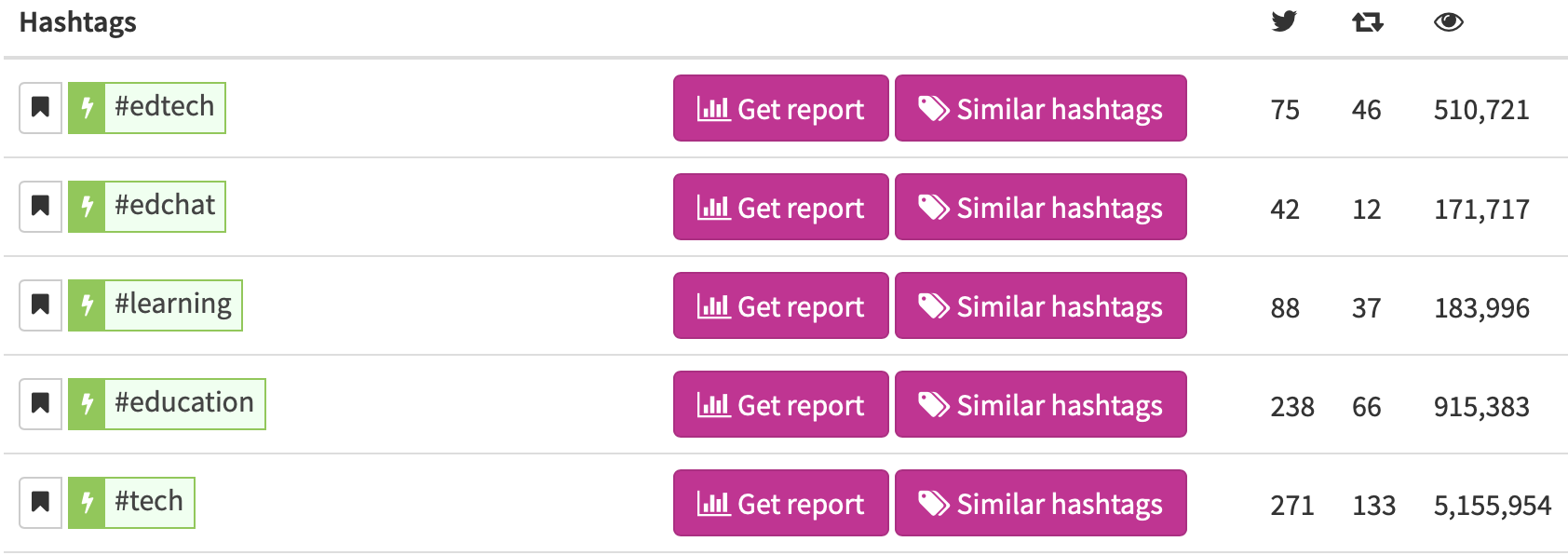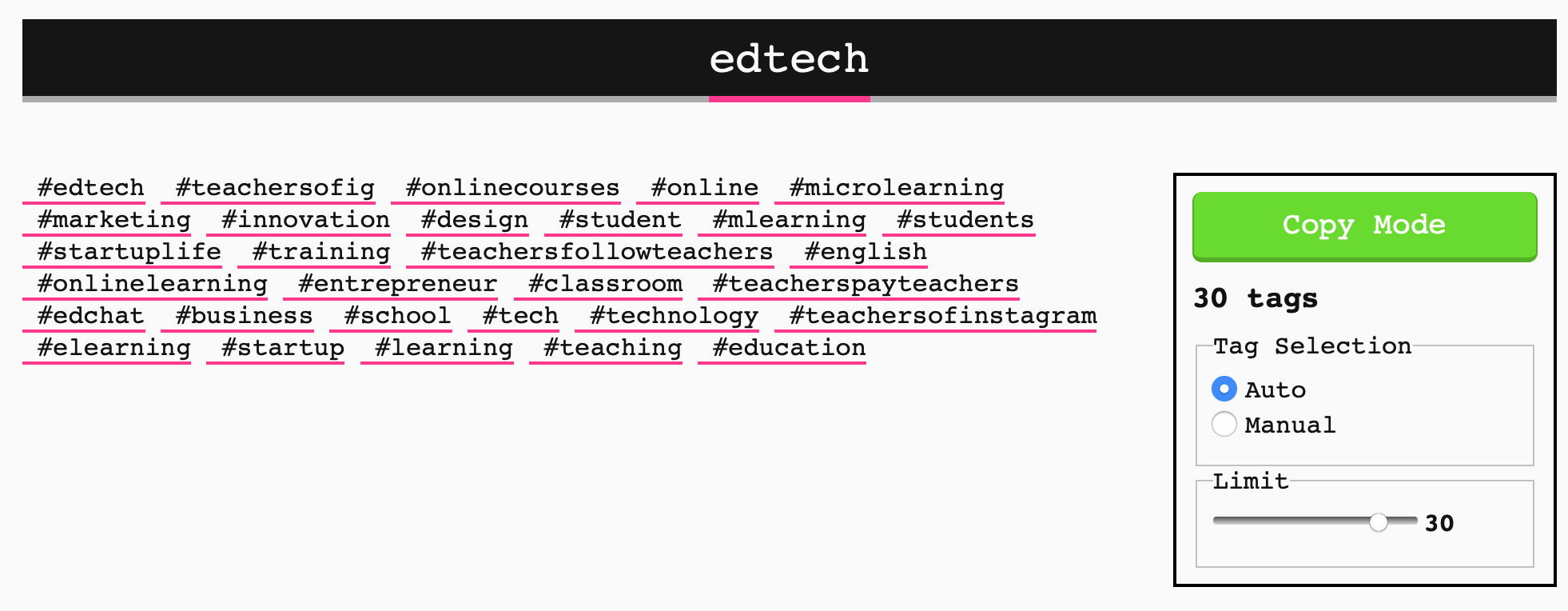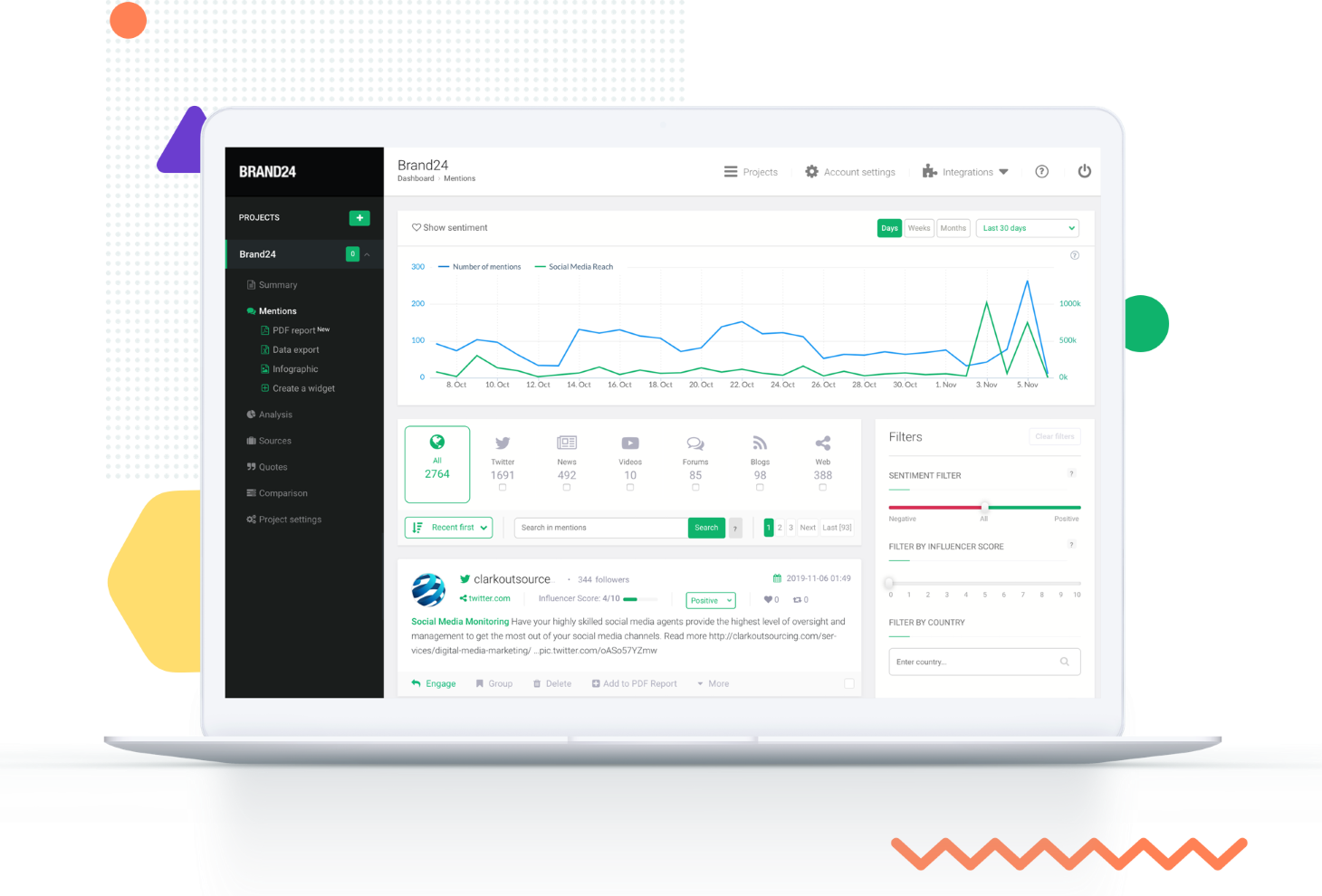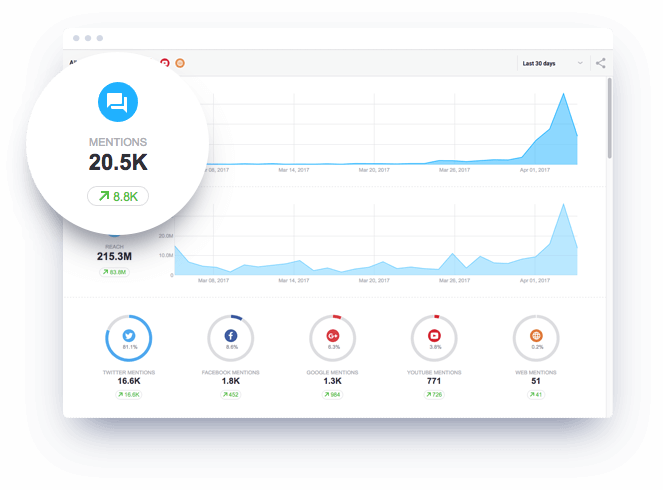Using the right hashtags can significantly increase your reach, engagement, and ultimately referral traffic on Twitter. Our team has crafted a lot of hashtag strategies, specifically for Twitter, for our clients and during this time, we’ve learned a lot. We’d like to share some paid and free tools that we’ve used to help you choose the best hashtags for your brand.
Before we dive in, we’ve also provided some helpful hashtag best practices, which’ll help build your overall foundation and help you avoid some mistakes along the way. And now for the tools!
Free/Freemium Hashtag Tools
1. RiteTag
Good for: Checking the reach of any hashtag
Platforms: Twitter, Instagram, Pinterest
Cost: Free / Freemium
We’ve used RiteTag for quite a while because it’s easy to use and free. While it’s not perfect, you can easily search for your hashtag and learn how many impressions it gets per hour. Ritetag offers other paid products that enhance your social posts, create calls-to-action on links, and schedules and publishes posts. We tend to just use the top search bar and search for specific hashtags. Here’s an example of a search using #edtech.
If you click on “Get report” for any hashtags, it will give you a snapshot of the last 24 hours. As a social media agency, we typically just use this data as a quick snapshot of overall reach. We update these stats monthly but there is a danger of using this snapshot data, as social media changes so quickly. If you’d like data over a longer time period, you can pay for thirty days of analytics, which includes sentiment analysis, location reach, influencer data, word clouds, related emojis and hashtags used, and top tweets. You pay by each report and it’s actually quite hard to figure out what the exact price is.
For the #edtech hashtag report for one month, RiteTag uses Twitter’s API to calculate the price and asks you to pay $29 for a deposit and the actual price ranges from $29-$99. Given we use this tool to gauge the reach of thousands of hashtags in education, we haven’t yet purchased a report. But if we were managing a specific hashtag campaign, we might try it to quantify the ROI and gain some additional insights.
In addition to reports, you can also purchase their RiteTag pro tools, which seem to be more Instagram-focused. These pro-tools provide hashtag suggestions based on the copy you write, removes banned Instagram hashtags, provides hashtag comparisons, and even has an app (Android and iOS) that can suggest hashtags based on image recognition. Here’s an example of a comparison of some education hashtags.
Additionally, if you choose to upgrade to the paid version of RiteTag, you will get access to the Chrome or Firefox extension, the mobile app, and the integration with social media publishing tools (including Buffer and HootSuite). The RiteTag extension in social media publishing tools will provide you with hashtag extensions within the tools.
2. Hashtagify.me
Good for: Finding hashtags related to your brand
Cons: Limited suggestions with the free version
Platforms: Twitter, Instagram
Cost: Free /Freemium (Monthly plans range from $29-$311)
Hashtagify is a helpful tool that provides a quick snapshot of your hashtag’s popularity, a word cloud of related hashtags, influencers that tweet about the hashtag, top languages, countries, and tweets that that used the hashtags. With the paid version, you’re able to see a lot more of this data, as the free version gives you very little.
You can also get reports on the Twitter accounts you manage that provides custom suggestions on the best hashtags to use. You can also bookmark and organize the hashtags you’d like to analyze, and look at the most popular hashtags right now, of the week, and of the month. Fair warning: You never want to use a hashtag just because it’s popular and in the world of education, you’ll rarely see an education hashtag that’s trending. Remember, hashtags should be used to reach your target audience only and most popular hashtags like this list won’t do that.
3. Mono
Good for: Organizing and easy access to your most-used hashtags
Cons: No insights about hashtags / mobile-only (not available for Android)
Platforms: Better for Instagram but can be used for Twitter
Mono is an app that allows you to manage your own library of hashtags. With Mono, you can easily add your hashtags and sort them into different folders with different colors. It checks your hashtags for duplicates and copies the hashtags you’d like to use with a tap.
While Mono doesn’t provide any insights about hashtags, it’s a useful tool to help you keep track of which hashtags you’d like to use for your brand. You can use Mono’s color coded folders to organize your hashtags by topic, so that you can easily find the appropriate hashtags to add to your tweet or post. We recommend using other tools to find hashtags for your brand and check their reach, then using Mono to record and organize them.
4. Display Purposes
Good for: Gives you more related hashtags based on the hashtags you search for. Gives age ranges and genders for hashtags.
Cons: Tricky to navigate. Only gives related hashtags for Instagram. Does not provide reach.
Platforms: Instagram
This is a very simple tool but can be helpful for Instagram. Simply enter a hashtag into Display Purposes, and it will generate a list of similar hashtags for you to use. It does not provide any impression data for hashtags.
Pro tip: If you click the link “See Stats” button at the bottom, it’ll give you more hashtag insights such as related hashtags with a number of posts that used the hashtags, and provides brief demographic, language and gender information of hashtag users. Note: Since Display Purposes only provides hashtags intended for Instagram, we recommend only using it to find new hashtags, then using Ritetag to check their reach.
If your brand is primarily active on Instagram, then you may find this tool to be very useful. Clicking on the “See Stats” button will provide you with information such as the top countries and cities using the hashtag. If you’re aiming to reach an audience in a specific location, these insights can help you. You can also find the top posts that use a hashtag, which may help you see how that hashtag is being used. Keep in mind that Display Purposes only works with Instagram, so if you would like to focus on Twitter, you’ll need to do extra research or use another tool.
5. Tagdef - the Social Media Dictionary
Good for: Finding the meaning of a certain hashtag.
Cons: No analytics about hashtags.
Platforms: Twitter
Do you keep seeing a certain hashtag being used but have no idea what it means? You can search for it on Tagdef and find out. Tagdef is like a hashtag dictionary but the definitions are supplied by users (and you can be anonymous) so they may not be 100% accurate. Warning: Some of the ads on this page aren’t appropriate for a school setting.
The front page of Tagdef displays hashtags that are currently popular or trending on Twitter. While these hashtags most likely will not be related to your industry, you may find an opportunity to use one of these hashtags to “join the conversation.” Otherwise, your best use for Tagdef will be to check the meaning of a hashtag that you don’t understand. However, since these definitions are user-supplied, we recommend that you also double-check by searching a hashtag on Twitter and seeing how it’s being used.
6. Tweet Binder
Good for: Getting a view of a hashtag’s recent performance.
Cons: Free version has limited date range
Platforms: Free / Freemium
With Tweet Binder, you can generate a free report about a hashtag’s performance in the last 7 days. Use the search bar to look up the hashtag you want, and Tweet Binder will give you a report that breaks down the types of tweets using this hashtag, the number of contributors to the hashtag, the hashtag’s potential reach, and more. Note that if you use the free version of Tweet Binder, this report will be based on up to 200 tweets from the last 7 days. If you want to see more tweets or increase that date range, you will have to upgrade to a paid version.
7. Audiense
Good for: Finding hashtags being used by your personal audience.
Cons: No analytics about hashtags.
Platforms: Twitter
Audiense is a tool to help you identify and understand your target audience. While we primarily use Audiense to find audiences for our clients, it also has a feature to help you find hashtags relevant to your industry. First, you’ll need to create a free account. Then, create a new report and enter your Twitter username. Audiense will then email you a free report of your audience on Twitter.
To get to the hashtags, you’ll want to click the “See all segments” button. Audience will then display the top hashtags being used by your audience. For even further analysis, scroll down to see different segments of your audience and the top hashtags being used by each segment. If you click “View more details” under a segment, you’ll be able to find an even longer list of hashtags being used by that audience under “Content.” While Audiense doesn’t provide insights about the hashtags it displays, you may find it useful to see which hashtags are being used by your specific audience.
8. All Hashtag
Good for: Finding popular hashtags.
Cons: Limited analytics about hashtags as related to your industry.
Platforms: Instagram and Twitter.
All Hashtag is another tool to help you find more hashtags. There are 4 different tools within All Hashtag: Generator, Creator, Analytics, and Charts. The Generator tool will take a keyword and generate related hashtags around it. You will have three options with the Generator tool: Top, random, and live. “Top” will generate the most popular hashtags related to your keyword. “Random” will give you randomly selected hashtags that include your keyword. And “live” will generate hashtags that are being used in posts that contain your keyword. Here were our search results for the top EdTech Hashtags:
The Creator tool is simple; as you type into the text box, it turns each word into a hashtag. The Analytics tool will give you a limited amount of insights about a hashtag. Among these insights is a ranking compared to all hashtags, how many times it was used (although it doesn’t demonstrate a time span), and similar words to the hashtag. Lastly, the Charts tool provides multiple lists of the current most popular hashtags and the top hashtags of various categories.
9. Brand Mentions
Good for: Monitoring and getting insights for a hashtag.
Cons: Limited insights for the free version.
Platforms: Instagram, Twitter, Reddit, LinkedIn.
Brand Mentions is a social listening tool that includes a free hashtag tracker. Enter a hashtag into the search bar, and Brand Mentions will generate a free report. Even with the free version, you’ll be able to see useful insights about a hashtag, including the reach and interactions, top influencers, related hashtags, and the context in which the hashtag is most often mentioned. You can also see all recent mentions with that hashtag:
With the paid version, you’ll get access to even more insights, such as sentiment analysis and number of mentions by country. The paid version will also allow you to generate a report from a time span of years, while the free version is based on 7 days of insights.
10. #OneMillionTweetMap
Good for: Seeing hashtag usage around the world.
Cons: Twitter only
Platforms: Twitter
#OneMillionTweetMap allows you to see which areas of the world a hashtag is being used the most. Something unique about #OneMillionTweetMap is the various filters that will give you different ways to visualize a hashtag’s usage. You can zoom in and out of the map and see the hashtag in clusters, a heatmap, and/or a day and night layer. The Time Filter allows you to alter the time range up to 24 hours. There’s also a filter that allows you to see the sentiment of the hashtag in different places.
Paid Hashtag Tools
Finally, here are some tools that you can access after paying for a subscription. While we personally don’t use any of these, we included them because we thought you may find them useful. All of these tools have free trials for you to test them out before purchasing.
10. Brand24
Good for: Monitoring the performance and sentiment of your brand mentions.
Cons: Paid tool
Platforms: Twitter and Instagram
Cost: Monthly plans range from $49-$299
Brand24 is a more robust tool that tracks your brand mentions on social media and in podcasts. You can track hashtags on Twitter, Instagram, and other websites. It’s a good tool if you’d like to measure the performance of a social media campaign. You can track and analyze contests and campaigns based on hashtags. You can also find top influencers and measure the social media reach of your campaign.
Other cool features include the ability to count the number of tweets / posts for a specific hashtag and it can even provide a sentiment analysis. They also have some pretty nice exportable customized PDF reports (and don’t worry data nerds…you can also export to excel).
11. Awario
Good for: Getting insights about a hashtag’s popularity and sentiment. Finding influencers.
Cons: Paid tool
Platforms: Facebook, Twitter, Reddit, YouTube, Instagram
Cost: Monthly plans range from $24-$299
Similar to Brand 24, this is more of a social listening tool than just a hashtag tool. Aware tracks brand mentions “all across the Web” and provides the popularity, engagement, and sentiment analysis of hashtags. Awario will also find profiles that use your hashtags, which can help you identify your industry influencers. Here’s a side-by-side comparison of Brand24 and Awario to help you decide which one better suits your needs.
12. TrackMyHashtag
Good for: Tracking popularity and usage patterns of a hashtag. Competitor hashtag analysis. Tracking previous data.
Cons: Paid tool
Platforms: Twitter
Cost: Monthly plans range from $49-$249 (you can also do limited searches for free)
TrackMyHashtag’s free service provides analytics of the last 100 recent tweets that use the hashtag. It lists total tweets and contributors that use the hashtag and potential impressions and reach.
Note: Never ever use potential impressions and/or reach for anything. Any “potential” metrics measure who could see your tweet, not actual and we don’t want to live in this overly inflated world of analytics.
TrackMyHashtag also analyzes age demographics of users that tweet about the hashtag, top users (great for following!), and most retweeted and liked tweets that use the hashtag. It also gives competitor hashtag analytics and it can track historical data of hashtags starting from 2006.
As you’re starting to figure out, none of these hashtag analytic tools are perfect. Why can’t we just have one awesome tool that does everything we want?! If you’re a social media manager, you also feel our pain when it comes to publishing, listening, and engagement social media management tools.
We hope that between these twelve tools, you can can find a couple that meet your needs. And make sure to follow this hashtag blog series so you can learn hashtag best practices, helpful tools, and get an entire glossary of the best education-focused hashtags that can increase the reach and engagement of your tweets.
Author note: This post was created in collaboration with our Social Media Marketing Associate, Ariella Hayden.
Good Human Alert: We are not a paid affiliate of any of these products (i.e. we don’t get paid to write about them). We’re simply surfacing up tools we’ve found helpful.
Originally published July 15, 2021. Last updated 4/21/2023.



















